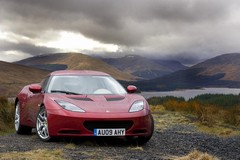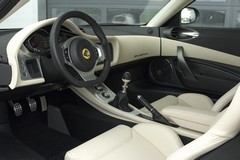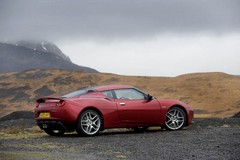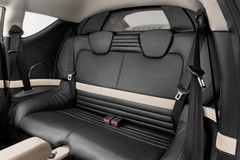Lotus Evora
Alisdair Suttie drives Lotus's new four-seater that brings the fight directly to Porsche
Lotus and four seaters don’t have the happiest of histories. From the wedges of the 1970s and ’80s through to the last four-seat Lotus, the Excel, the Norfolk squad has never really managed to combine carting about four people with its core philosophy of minimal weight. Now we have the Evora, Lotus’ first all-new car since the launch of the Elise more than 13 years ago and currently the world’s only mid-engined, four-seat sports car.
There will be a two-seat version of the Evora as an entry-level model, but Lotus expects most buyers to opt for the four-seater that was presented at the car’s rain sodden launch in Scotland. Lotus boss Mike Kimberley says: ‘This is the most important car for Lotus since the Elise was first launched. It stays true to our design values and we see it very much as the next step for existing Lotus owners as they move up and through our range.’
What this means is Lotus wants to hang on to customers who have done the Elise thing and usually head to a Porsche showroom for their next fix. To this end, the Evora inevitably attracts a lot of comparisons with the Porsche Cayman, but a more apt rival is the 911 as it also tries to offer a modicum of practicality alongside a hefty dollop of performance and handling prowess. Looked at in this way, the Evora emerges as an intriguing choice and pushes Lotus into a territory it hasn’t occupied since the Esprit bit the dust.
Can Lotus live in this rarefied atmosphere of fifty grand-plus motors when it’s been used to selling lightweight, no frills sports cars and track day toys for so long?
First impressions are spot on. The Evora exudes
the simple, clean profile that exemplifies Lotus. There are plenty of detail touches that set it well apart from other small British manufacturers and show that the styling department at Lotus is every bit as able as the men in brown coats from the engineering shop. It’s a clean, lithe look in the flesh that makes the Noble M15 look slab-sided and certainly elevates Lotus as worthy of comparison with Porsche.Underneath the pert bodywork lies a new bonded aluminium chassis tub that shares nothing but its inspiration with the Elise. Lotus is very definite about pointing out that the Evora is an all-new car and not a derivation of the Elise. So there.
Peerless structural stiffness is a given, but what’s more impressive with the Evora’s chassis is it manages this without demanding the driver be a contortionist to fit in the car in the way an Elise does. Open the low weight door and you simply slide into the driver’s seat and get snug. Getting into the rear seats is a different matter altogether. The front seats tilt forward, but the amount of space provided for clambering into the back is minimal and even tiny tots and the seriously short of leg will still find it cramped. Then there’s the negligible window area for those in the rear. Add it up and the Evora doesn’t really cope as a four-seater, even one that tries to get round this by calling itself a 2+2. Still, the bench provides a useful amount of extra storage space to supplement the small boot behind the engine bay.
In the front, the driving position is surprisingly high-set, though this is no bad thing for comfort and vision through the broad front windscreen. As for rearward vision, the tiny screen at the back gives just enough of a picture in the rear view mirror to monitor what’s going on behind.
Lotus has put a lot of effort into the Evora’s cabin, mixing materials, shapes and finishes to get away from the bare bones Elise and offer something to tempt people out of Porsches and BMWs. The first 450 Evoras built will come laden with the Tech (£2450), Premium (£2450) and Sport (£950) packs, as well as Xenon headlights and a reversing camera. The Tech pack brings an Alpine stereo with touchscreen display to work the satellite navigation, while cruise control and rear parking sensors are also included. Tick the box for the Premium pack and leather covers the seats and just about every other surface, though this didn’t stop some of the trim coming loose in the car we drove. Quite why a Lotus should need a Sports pack is mystifying, but go for it and you’ll have a button that switches between the normal setting and one with enhanced throttle response and that ups the rev limit by 400rpm to 7000rpm. This pack also provides a titanium exhaust, cross drilled brakes, diffuser and engine oil cooler to appeal to buyers who fancy some track day action.
Speaking of the engine, the 276bhp 3.5-litre V6 is donated from Toyota in the same way the Elise uses a four-cylinder motor from the same source. Lotus has come up with its own ECU electronics for the engine to give it quicker responses and a rortier edge. However, you can take the engine out of a Toyota but you can’t take the Toyota out of the engine. It is relentlessly efficient, delivering a seamless and linear power band that has plenty of low-down urge that builds easily and calmly to a peak as the change lights flicker inside the rev counter.
There’s a definite added urgency to the engine as it gets above 4000rpm, but there isn’t quite the howl and yowl from the V6 to denote this is a car that cracks 0-60mph in 4.9 seconds and tops out at 162mph. Yes, it sounds good, but there isn’t the tingle in the spine you get from a Cayman at full chat. However, the six-speed gearbox in the Evora has well spaced ratios that mix hard driving and cruising with aplomb. There’s also the option of a sports ratio gearbox for £1450 that shortens the upper four gears so that sixth in this ’box becomes equivalent to fifth in a standard car’s gearbox.
Pressing on through the murk of the early Scottish summer, we didn’t find ourselves wishing for the sports gearbox. Instead, we were mightily impressed with the flexibility of the gears and engine, using third and fourth for most occasions to dispatch overtaking or the few straights that join up the spaghetti of corners in this part of the world. We were also impressed with the Evora’s refinement when cruising, with road, wind and engine noise all given their marching orders to prove that the Evora is more than up to the task of providing owners with realistic everyday transport.
Back to the corners and what the Evora does best. Yes, it’s a Lotus and it engages corners with the kind of poise and precision that almost every other car maker in the world can only wonder at. Light-ish weight – the Evora tips the scales at 1382kg with 61% leaning on the rear wheels – and supple suspension come together in what must be the
most accomplished ride and handling balance of any car in this class. Lump-addled roads are caressed by the Evora’s suspension to allow incredible levels of grip in bends, and this is complemented by steering with the sort of feel, weight and accuracy that tells the driver all he or she needs to know without it ever becoming flighty. The only fault we can find here is the reach and rake adjustment for the Evora’s steering wheel which doesn’t work with the same fluid action as a Porsche’s, and frankly this is nit-picking on a grand scale.Finding other nits to pick with the way the Evora drives turns up almost nothing. The gear shift from first to second felt a little truculent and needed a firm, deliberate hand to guide it home in the car we tested, and there’s not a huge amount of room for the driver’s right arm. Other than that, the only criticism we can come up with is the pedals are offset to the centre of the Evora due to the front wheelarch, but it’s something we soon got used.
We can’t even moan that the Evora delivers such an inspiring drive at the expense of economy or the environment. Combined consumption is a claimed 32.5mpg and carbon dioxide emissions of 205g/km compare very well against the Evora’s rivals. With a 60-litre fuel tank, the Lotus also has a respectable 400-mile range between fills.
So, the Evora has everything needed to survive and thrive at the upper end of the sports car market. Superb performance, handling, comfort and build quality that, in the most part, appears up to the job. Just as well, as the Evora starts at £47,500 for the 2+0 two-seater and £49,875 for the 2+2 that’s expected to be the big seller. Okay, so Lotus hasn’t managed to come up with a four-seater with which it can lay to rest its uneasy past with family-friendly sports cars, but it doesn’t really matter. The Evora is sensational to drive and puts Lotus firmly back among the big players.
Gassing Station | General Gassing | Top of Page | What's New | My Stuff








